The BAREBOW! Chronicles: Dealing with the Defensive Perimeter
Dennis Dunn 08.18.15
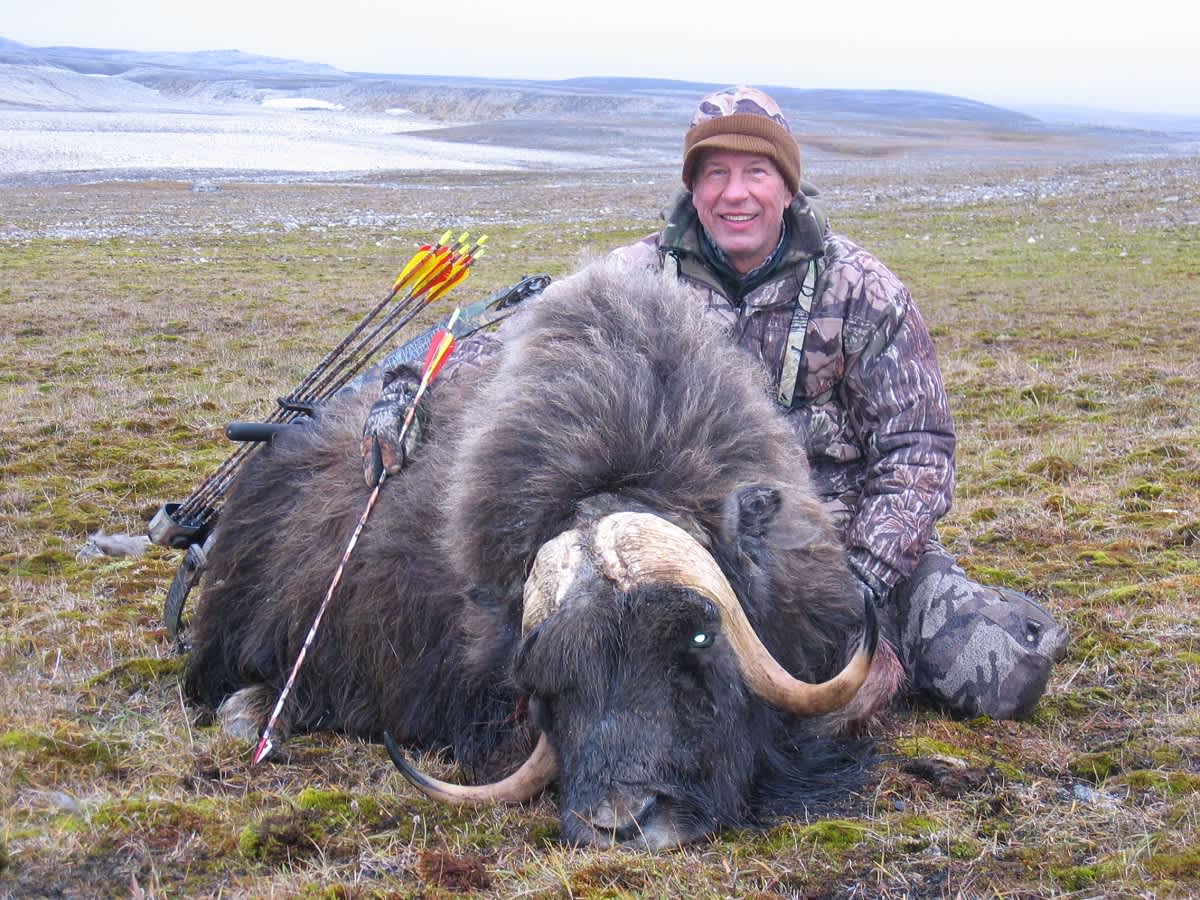
Considering the very satisfying, double success of my 2001 muskox hunt on Banks Island, I did not have any thought in my head of hunting the species again—until one day in the spring of 2005, when suddenly the phone on my desk rang. It was Mark Buehrer, of Bowhunting Safari Consultants, calling to ask if I’d be interested in taking part in a muskox hunt out of Resolute Bay which he was putting together for well-known bowhunter Tom Hoffman. Hoffman is unquestionably one of the top bowhunters in the world, and I have had the privilege of regarding him as a friend for the past nearly 30 years.
The hunt was to start on the final day of that August, and, although Tom would not be hunting, he was looking for five experienced bowhunters to join with him and his friend, Nathaniel Kalluk (an Inuit from Resolute Bay), for the first-ever, modern archery hunt for muskox on Somerset Island. Because I had never before shared a hunting camp with Tom, and also because of my great admiration for him, I jumped at the opportunity which Mark dropped in my lap with his phone call. The four other hunters who would be joining Tom and me were Stacee Frost from Alaska, Greg Bokash and Jeff Podosek from New Jersey, and Dr. Mike Wilson from Kansas.
I knew Stacee already, as she is the daughter of another legendary bowhunting friend of mine, Dr. Jack Frost of Anchorage. Stacee had already achieved some considerable notoriety in her own right as the first lady bowhunter ever to take a grizzly bear with a bow (2002). In 2006, Stacee also became only the second woman ever to harvest a polar bear by bow and arrow, and more recently she has taken both the Alaskan brown bear and the black bear, becoming the first lady bowhunter to claim all four North American bear species.
In pursuit of both polar bear and muskoxen, Tom Hoffman had been on several previous hunts with Nathaniel as his guide, and the two of them had become fast friends. Since Tom and Jack Frost are very close friends, part of Tom’s motivation for putting together this hunt in which I was fortunate enough to participate was to help Stacee take her first muskox. I believe the rest of his motivation was to help Nathaniel establish sport hunting on Somerset Island as a viable economic enterprise.
Somerset—located on the 73rd parallel, well north of the Arctic Circle—is one of the larger islands in the Canadian province of Nunavut. It comprises nearly 10,000 square miles and is uninhabited at the present time. Around 1000 AD, however, Somerset was inhabited by the Thule people. The last of their descendants abandoned the island only in 2004. I was fascinated to learn that Nathaniel’s wife had actually been born on Somerset, and that—in fact—Nathaniel’s family was the last one to leave. They had done so in order to secure a better education for their children in Resolute Bay.
The 200-plus residents of Resolute pride themselves on being able to say that their tiny hamlet is not the end of the earth, but that “you can see it from here.” In their native tongue (Inuktitut), the community is called Qausuittuq, meaning “the place with no dawn.” During the hard winter months, there are many consecutive weeks when the sun never rises there. Even in perfect weather, with no clouds in the sky! Resolute is so remote that when I flew due north from Ottawa, Canada, to get there, in late August of 2005, the flight covered almost as many air miles as did my flight from Seattle to Ottawa. We Americans tend to think of Ottawa as being pretty far north!
The Kalluk family had briefly made their home on Somerset Island at Creswell Bay. It must have been a great location for their nomadic ancestors to camp, because during the month of August there is a huge run of Arctic char that returns to the Creswell River every year. As the bright silver fish make their way up the short, gin-clear river to reach the enormous lake in which they will spawn and spend the winter under the ice, they can be easily speared from the banks. Over the many, dimly-lit centuries of the past, there can be little doubt that the four principal food sources of the Inuits and their forebears have consisted of caribou, seals, muskoxen, and Arctic char. Beluga and narwhal whales can be added to that menu, as well.
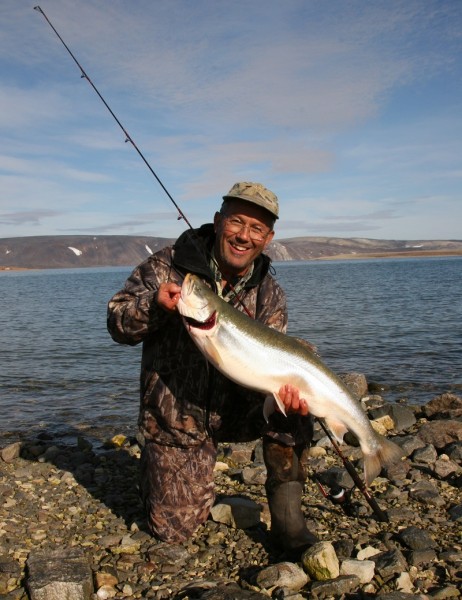
After making the long, hour-and-twenty-minute flight back southward from Resolute to Creswell Bay, we could hardly wait to get unpacked and break out the fishing rods. The hunting would not start until the next morning. One of the things all of us greatly enjoyed about this exotic adventure was the ease with which we could catch the char at the mouth of the river. Being an old fly fishing addict from way back, I eschewed the use of spinning reels and metal lures in favor of a fly rod and a few carefully-tied flies that I had packed in my luggage. All the others caught more fish than I did, but I managed to hook and land three on my fly and that was enough to make me happy. According to Nathaniel, the run was already tapering off rather severely by the time we arrived at Creswell Bay; I can scarcely imagine what the fishing would have been like during the peak of the run two weeks earlier.
It had taken everyone in our group three days of travel just to get to Somerset Island. Counting the days of arrival and departure, the entire stay was to be less than six days, so that left only four for the hunt itself. Because I was the only one among the five of us hunting who had already taken a muskox with a bow, I volunteered to stay in camp on the first day. Nathaniel had only four quads available. Since Tom had come along primarily to video the whole adventure, and since Nat had two assistant guides working for us also, that made a total of nine people to distribute amongst the 4x4s. Two persons per rig was the limit, so somebody had to stay behind in camp each day. Not only did I consider myself the logical choice on day one, but I also couldn’t wait to do some more fly fishing at the mouth of the river only a quarter-mile away.
Shortly after noon, I glanced over at the little cluster of old shacks and modern tents which constituted our camp and noticed two of the four-wheelers returning from the hunt. The back-ends of the quads were piled high with meat and Muskox hides. Curious to know who had been successful, and eager to see their trophies, I waded out of the current and trudged back along the beach. Stacee and Mike had both scored with excellent Pope and Young bulls and had exciting stories to tell.
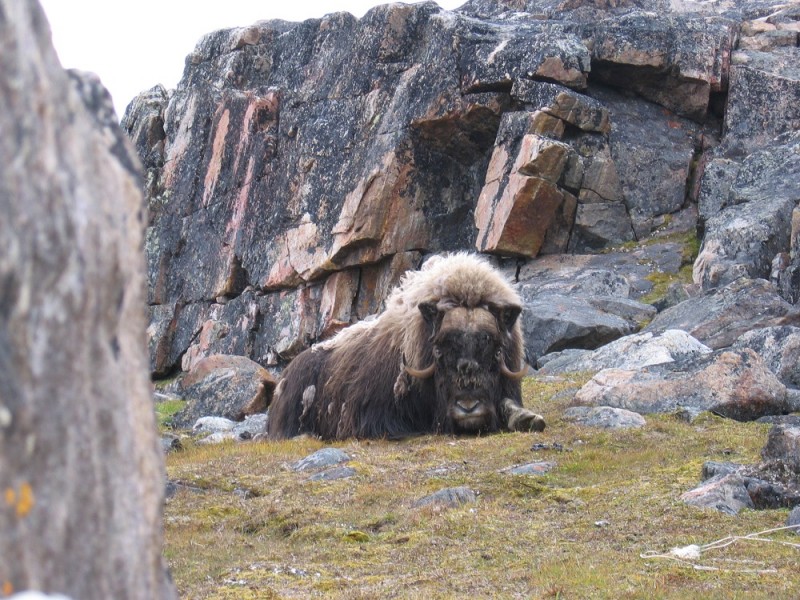
On day two, Mike offered to stay in camp so that I could go off hunting and see some of the island’s extraordinary landscape. I told Jeff and Greg I just wanted to go along for the adventure and wasn’t interested in trying to take a bull until they had both filled their tags. In my opinion, the biggest challenge in hunting muskox is just to find some. With no vegetative cover whatsoever to hide in, the reader might suppose them to be quite easy to locate. You really have to have spent time in the High Arctic in order really to comprehend how truly vast the spaces are which the native wildlife inhabits up there north of the Arctic circle.
Containing nearly 10,000 square miles of rolling, semi-mountainous, barren desolation, Somerset Island offers to those souls adventurous enough to penetrate her outer perimeters innumerable vistas that resemble what I would imagine the surface of the moon to look like. It does, of course—during the short growing season (until the snows return again)—also hold countless little pockets of tundra grass tucked away here and there. Those are the places that attract the nomadic muskoxen, since they are totally herbivorous and do not digest rocks well.
Once a year, the government of Nunavut conducts by helicopter a census survey of the muskox population on Somerset. The 2004 census count was about 800 muskoxen, but the 2005 count was less than 300. The huge drop did not indicate that the resource was in trouble. It was simply indicative of the radical, annual vicissitudes inherent in the winter peregrinations of the species, as they wander about from island to island on the frozen surface of the Arctic Ocean. When that ocean finally breaks up and thaws by midsummer, the muskox are “trapped” on their temporary piece of Arctic real estate until the surface freezes up again in October.
Ten-thousand divided by 300 gives us a quotient of around one animal for every 33 square miles of ground on Somerset Island. However, since muskox are definitely herd animals, it is very possible that at the time of our 2005 hunting expedition to Creswell Bay, the island only contained one herd for every 150 or 200 square miles. Whatever the case, days two and three necessitated many dozens of miles of travel on our quads before any animals were ever located that we could try to stalk. Because of the distances involved, hunting the muskox on foot is just out of the question. The Inuits hunt them either on quads or on snowmobiles, as do the nonresident hunters whom the Inuits guide.
With regard to the hunting of this particular species of North American big game, the use of the word “stalk” is probably inappropriate. I have seen a few situations in which the contours of the terrain might have allowed a hunter to sneak within bow-range, sight unseen, but almost always in muskox country there is no way to get close without being spotted by your quarry—unless, of course, it is a lone, bedded bull you have stumbled upon. More than one pair of eyes will nearly always find you in short order.
Such was certainly the case with the two separate herds of muskoxen we finally managed to find for Jeff and Greg in the afternoon of day two. Because the regulations for nonresident hunters do not permit approaching an animal any closer than one mile on motorized vehicles, once we found a group off in the distance, we got off our machines and continued on foot. Jeff drew the longer of the two straws, so he led the way as we slowly walked right toward the first herd of six. I firmly believe that none of the muskoxen we saw on Somerset during our three days of hunting them had ever seen a human being before. I don’t think they had a clue as to what we were. As we drew close, the herd displayed only minimal nervousness and moved off 30 yards or so up into a big pile of rocks and boulders. There was just one, big, mature bull in the bunch, and Jeff managed to make a great shot on him. He ran perhaps 40 yards, lay down, and the drama was all over in short order.
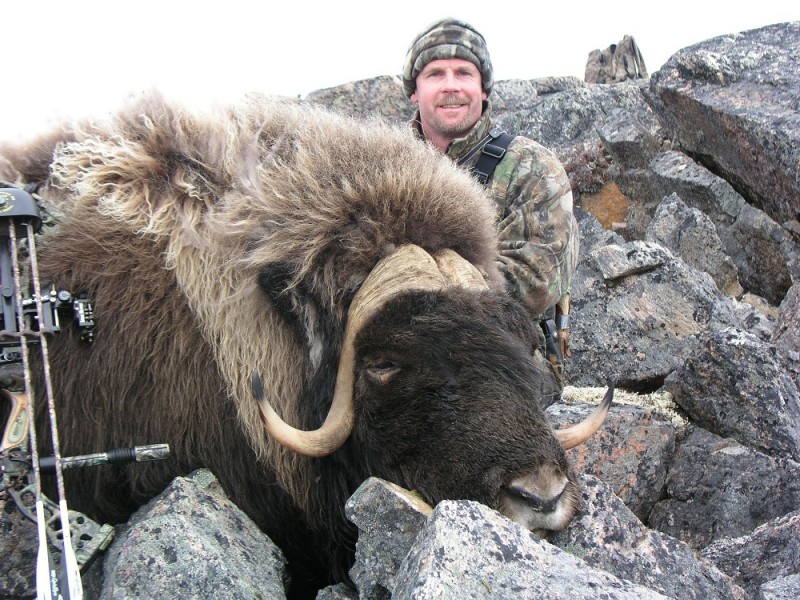
Later that afternoon, perhaps 20 miles further on beyond the first muskox encounter, we spotted three more of the prehistoric-looking creatures drinking from a wet stream bed 500 yards in front of us. This time it was Greg’s turn to try to fill his tag. As we proceeded on foot and slowly closed the distance between us and them, by angling obliquely towards a slightly elevated spot about 35 yards off to the side, the three paid us scant attention.
All were bulls, it appeared, but only one was an old bull possessing horns of trophy quality. Greg quickly declared that this bull was good enough for him and began circling the trio until he got the broadside opportunity he was seeking. The rest of us maneuvered into position behind him in order to capture the action on tape with our video cameras. When everybody was ready, Greg drew and released an arrow that disappeared right through the old bull’s rib cage, and an hour or so later we were loading the last of the meat on the back ends of our quads, to begin the long return trip to Creswell Bay.
Day three was my day to go looking for a trophy bull. I knew I was going to be pretty selective, and when Mike offered to come along with us (me, Nathaniel, and his assistant)—in order to video-tape whatever drama might ensue in the hunt—I told him I really was not intending to shoot one unless we could find one bigger than either of the two I had taken back in 2001. He insisted he wanted to come anyway, and I told him I’d be delighted to have his company.
Immediately following another great breakfast prepared by Nat’s wife, Martha, the first thing my guides did was to load two four-wheelers into each of two, small aluminum boats. As heavy as those quads were, I frankly don’t know how they managed to manhandle those rigs aboard. Yet the Inuit people are nothing if not absolutely ingenious at confronting and overcoming difficult challenges. This was my fifth trip to the High Arctic, and I was no longer allowing myself to feel too amazed at any of the steady string of little “miracles” they constantly pull off in coping with the harsh environment in which they so clearly enjoy living.
Once all of us and our gear had joined the quads in the two heavily-laden boats, we shoved off from the beach and used the big outboard motors to speed our way about 15 miles up the southeastern coast of the island. Nat was determined to hunt a part of the island that had not been hunted yet. When we nosed our crafts up onto a well-protected, fine sandy beach, the scene that greeted us was almost surreal. The water was crystal-clear, yet even with a mostly-overcast sky its color was somehow a gorgeous, Mediterranean blue.
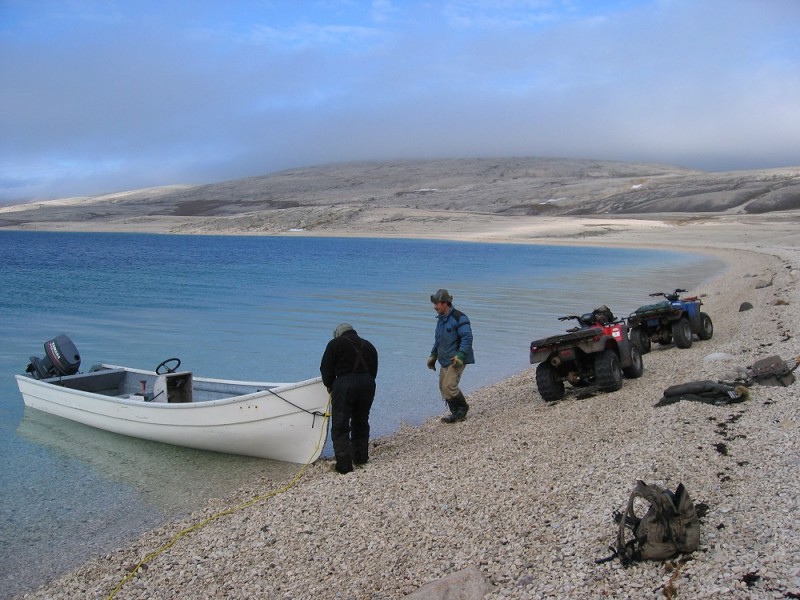
The color green was nowhere visible. Except for the water, everything about the barren, rugged landscape was gray, brown, black, inhospitable, and intimidating. Disappearing up into a mighty fog bank in front of us were the coastal flanks of the island. In response to my inquiry, Nat explained that we would have to gain about 1,000 feet in elevation before reaching the high plateau that would then afford us relatively easy travel. He said he knew a route which would allow us to get our four-wheelers up “on top” without too much risk of coronary thrombosis.
Getting the quads out of the boats and onto the rather sharply-inclined beach was the first challenge, however. That accomplished, we were soon rolling onward and upward on what promised to be a first-class adventure into the shrouds of mystery and history. According to Nat—where he was taking Mike and me—he didn’t believe any white man had ever set foot. Only himself, his family, and his ancestors. Our ride to the top was steep and “hairy” in places, but the panoramic vistas out over the ocean were absolutely breathtaking along the way. As far as I was concerned, the “roof” of the island (also known as its interior) made me think I was on the surface of some unexplored planet in some distant solar system. It seemed even more alien than I had imagined our moon to be.
Fortunately, the abundant supply of oxygen gave substantial reassurance, and I periodically gulped in big lungfulls of clean, sterile air. It seemed to have little odor or fragrance of any kind, but it certainly was crisp, fresh, and invigorating. And, as I said—“reassuring!” For miles on end, there seemed to be no green anywhere. As far as the eye could see into the interminable distance, the unrelenting shades of gray, brown, and black gave you no relief. Many small canyons cut the surface and forced us to make numerous, long detours. Occasional craters pockmarked the unearthly landscape, and we also encountered a fair number of cones that rose up sharply as much as a couple hundred feet above the alien-looking surface. These latter were not volcanic in nature, but instead had pointed summits comprising only a very few square feet of space. One in particular (which we stopped to climb) I found to be utterly fascinating! The flat area on top couldn’t have been more than 18 inches on a side, but it was covered in lush, green grass—the first we had seen all day!
And thereby hung quite a tail. Or perhaps I should say tail feather! Caught in the long grass of the little summit was the feather of a great snowy owl that had quite obviously used the lofty perch to scour the land visually for his own hunting purposes. The more I studied that quarter-square-yard of greenery, the more I realized I was learning things about Somerset I could never have learned in any other fashion.
Muskoxen and wolves were not the only wildlife on the island, after all! Scattered across the top of that shocking little patch of intense green were numerous, olive-colored turdlets—sprinkled with countless, tiny, white inclusion specks.
“Why, they’re bones!” I exclaimed to Nat, while down on my hands and knees.
“Lemmings!” responded Nathaniel. “The number one food source for our birds of prey.”
“Wow!” I said. “I haven’t seen a single lemming in the three days we’ve been here!”
Nat smiled. “But you don’t have the eyes of an owl,” was his matter-of-fact reply.
It wasn’t until around 3 p.m. that we finally found a small herd of muskoxen. The search had been long and tedious, but the act of suddenly spotting something alive—and so very large—in the middle of such vast nothingness was, indeed, quite a thrill. They were four in number, and they were located nearly a mile away, part way up the other side of a steep, forbidding-looking canyon. It took our leader a good half-hour to find a way that allowed the quads to get over or around all the many obstacles, but, when Nat judged that we were finally within easy walking distance, we killed our engines and prepared for the final stalk. It felt a great blessing to have my legs on solid ground again. The bumpy ride had been more than long enough.
The four muskoxen were not yet visible to us, but Nat’s hunch as to their location proved correct, and two hundred yards of walking brought them into view. Not surprisingly, they were feeding on a surface covered with yellow-green grass. What I found stunning was the size of the piece of greensward: it dwarfed anything else we’d seen all day long. Our quarry noticed us almost immediately and turned to stare at us in curiosity. Once again, the thought passed through my mind that we were no doubt the only humans they had ever laid eyes on.
With the four of us giving them vertical profiles as we moved in, they knew we were not wolves, but—out of pure instinct—they took up their famous, defensive formation, anyway. Because we were approaching from only one direction, they didn’t need to form a circle, all facing out. Instead, the two bulls had staked out their end positions by placing the two females in between them, and all four were arrayed in a tight, semi-circular line facing us.
They stood below us, on a little bench. When we had closed to about 50 yards, I gave Nat my camcorder and asked if he’d be kind enough to film the impending drama. He happily agreed, and Mike got out his own camera,=as well. Nat pointed at the bull on our right and advised me to try to take that one if I could get a good shot angle. I had, however, already been studying the horns of both bulls through my binoculars and had come up with a strong preference for the other bull. Nat’s choice was clearly the older of the two bulls (possessing wider bosses on his forehead), but the bull I liked better had much longer (and more massive) horns. I knew instinctively that he would score better than either of the ones from Banks Island, and I let Nat and Mike know that I was going to try to harvest the younger bull. In body-size, the two were very comparable.
As I neared the bottom of the hill, I detached an arrow from my bow-quiver and placed it on the string. The more I focussed on the left-hand bull, the more convinced I became that I had made the right decision. His yellowish horns carried their mass very well, right through the long upward curve that started at the bottom of the long down-sweep. His horn tips seemed lengthy in their own right and were a gleaming, ebony-black.
My biggest problem—as I knew it would be—was obtaining an exposed, broadside shooting angle at the big fellow’s rib cage. The old cow next to him was standing very close and blocked out my line of sight to all but his head, neck, and shoulder. As I narrowed the distance to about 25 yards, the bulls began warning me to come no closer. Nat called down to me that I should not approach any further. Both bulls were slowly rubbing the inside of their front ankles with their furry muzzles. That was the clear signal that a charge could be imminent.
Deciding I’d better respect that invisible perimeter line (i.e., their safety/comfort zone), I began to pace back and forth above them—waiting for the right moment, the right opening. Eventually, the growing restlessness of the beasts started generating enough movement among the four of them that I became hopeful I might soon get the shot opportunity I was seeking. Finally, the left-hand bull stepped forward a bit, at last exposing the front half of his rib cage.
Right away I began to draw back, but just as quickly I let down—with a smile on my lips. No sooner had the bull moved forward than the cow had followed suit. My target had been in the clear for only about three seconds—maybe less. Patience, alone, would be my trump card.
Luckily, a minute later, the bull took another step forward, barely revealing the small, thick patch of hair which I figured covered the location of his heart. This time the cow stayed put, and the moment of truth had arrived. The right-hand bull was facing directly at me, but the one I wanted stood exactly broadside to me, with his nearer front leg pushed ahead and giving me full access to his vitals. Since both animals seemed—for the moment, at least—frozen in place, I drew, anchored my string-fingers under my cheek-bone, and took long, deliberate aim. I wanted this to be super clean and quick, the way it was on my second muskox hunt. The first one had been a nightmare that I never wished to repeat!
The heavy overcoat of my quarry was obscuring most all of his body contours. Yet—as I stood there for perhaps nine or 10 seconds at full draw—I gradually developed a strong intuition as to just where the heart lay. With a degree of calm and confidence that rather surprised me, I finally released the arrow and watched it vanish into the precise spot at which I’d been looking. I had, indeed, made about as perfect a heart-shot as I could have hoped for. Thirty seconds later, and only 10 yards away from where he had unknowingly made his “last stand,” my bull was on his back, and it was all over save for a few, final, muscle contractions. One arrow had been all that was needed.
Mike walked up from behind me and extended his hand. A few seconds later, Nathaniel and his helper were there, adding their congratulations. After the silly, but mandatory, onsite trophy photos were completed, out came the skinning knives, and the hard work began. I really don’t know how many four-wheeler miles it was from the site of my muskox-kill back to our boats on the beach, but by the time we finally reached them there wasn’t a lot of light left in the sky. A late supper was awaiting us, and then we all hit the sacks pretty well exhausted. It had been quite a day.
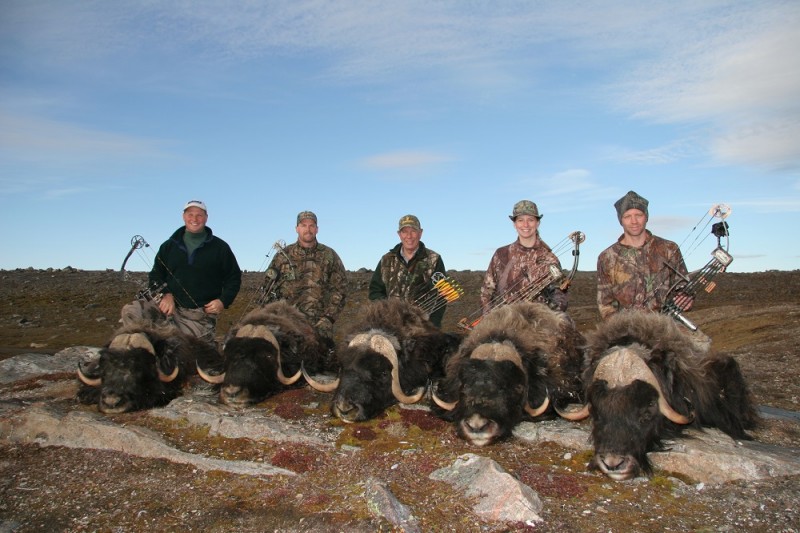
Our last full day in camp was utterly delightful. It involved unexpectedly sunny weather, preparing our Muskox trophies for transportation home, further fishing adventures at the river, and an afternoon boat-ride to which Nathaniel treated us all (in two separate vessels), that actually—for some of us—proved to be the highlight of the entire trip. Nat wanted to show us an ancient encampment that his wife’s forebears had used during the summer seasons, for hunting the belugas and narwhals.
None of us were prepared for what we saw. Though there was not an anthropologist among us, we were all completely mesmerized by the silent history that spoke such volumes to our eyes and minds. Here was truly an instance where “the silence was deafening.” What lay before us on a verdant, mossy bank, rising only a few meters above the cerulean waters of the Arctic Ocean, were the substantial remains of dozens of sod huts that long ago had been “timbered” with the ribs (and other bones) of various and sundry types of whales. Flat white rocks and curved bleached-out bones lay everywhere—scattered across an area of perhaps 30 by 100 yards.
Nothing could really still be said to be “standing,” but some of the lower passageways and inner rooms could be easily discerned. For walls and roofing, pieces of sod had been carefully removed from a sizable part of the big, lush “front lawn” that swept down to within a few feet of the water’s edge. You could clearly see the large, rectangular, precisely-cut, sunken plot of ground from which the sod had originally been taken. The grass inside the rectangle was uniformly four to five inches lower than the grass outside the rectangle. It was truly one of the most remarkable sights (and sites) I have ever witnessed.
Yet that was just for openers! Nathaniel had other surprises in store for us. On the way to our next “tour stop,” he asked us if we knew what “that white blob” was, bobbing on the surface about 200 yards ahead of us. Within seconds, we realized it was not an iceberg—but a polar bear out for a sunny afternoon swim some 300 hundred yards offshore! Although we didn’t harass it with our boats, we did all manage to get some great photos as we slowly passed him by. He did not seem to be at all happy about having been discovered without his feet on the ground!
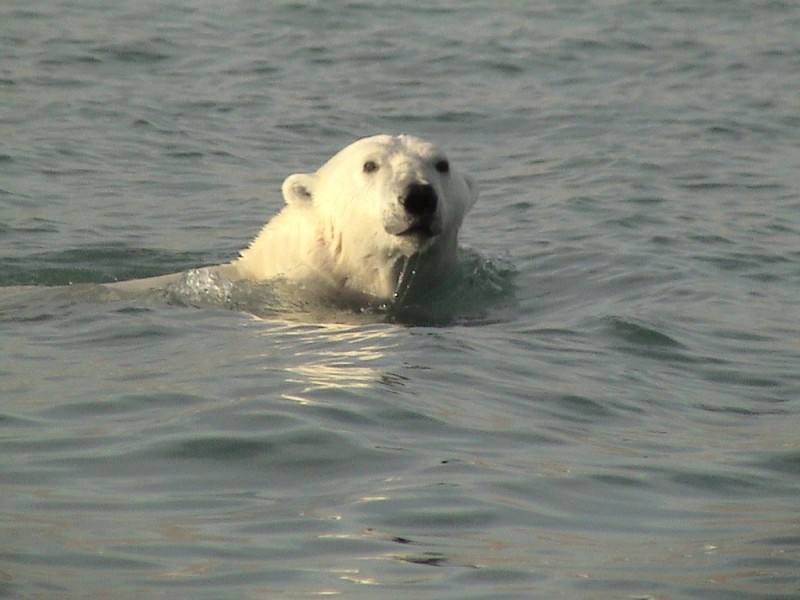
The final stop on our tour was yet another encampment-site of the ancient Thule people. This one was even more impressive than the first. The most imposing “structure” of all—or its remains, anyway—had pieces of bone rising several feet above ground-level, and arranged in a large, perfect circle. These “pieces,” however, were all whale skulls—each one huge, and heavier than I could lift. From fifty yards distant, they looked like big piles of snow and ice that hadn’t yet finished melting. You simply could not escape feeling a sense of profound awe as you tried to imagine the people who so long ago had used the edifice as a community hall, or an infirmary, or whatever else it may have been!
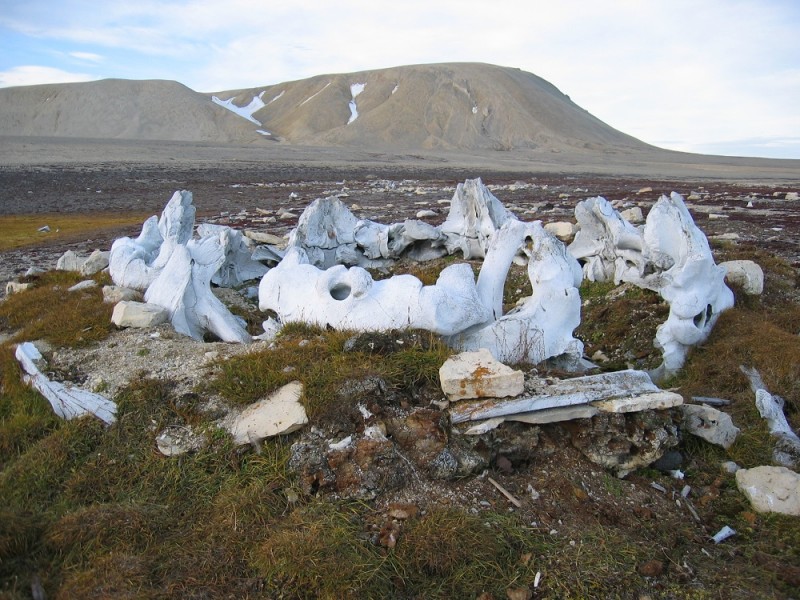
All in all, my trip to Somerset Island turned out to be one of the most fun and fascinating hunts I have ever been on. Tom Hoffman knew it would be special for all of us, and he went to extraordinary lengths to make it so. Among other things, he had brought up there with him, for our gustatory pleasure, a big box of fresh corn on the cob, and another one of fresh peaches. Each of us had had to pay a king’s ransom—just to get there and back home again—but we ate like kings!
Add to that Tom’s hunting stories and his constant, jovial good humor, which always infects everybody around him, and the reader will understand why I consider myself so lucky to have been invited along on that adventure. Not to say anything of the great hunting and fishing! The money spent was well worth it, and then some! Tom and Mark (Buehrer)—we are much in your debt. Once again, thanks, friends!
Editor’s note: This article is the fifty-third of the BAREBOW! Chronicles, a series of shortened stories from accomplished hunter and author Dennis Dunn’s award-winning book, BAREBOW! An Archer’s Fair-Chase Taking of North America’s Big-Game 29. Dunn was the first to harvest each of the 29 traditionally recognized native North American big game species barebow: using only “a bow, a string, an arrow—no trigger, no peep sights, no pins—just fingers, guts, and instinct.” Each of the narratives will cover the (not always successful, but certainly educational and entertaining) pursuit of one of the 29 animals. One new adventure will be published every two weeks—join us on the hunt! You can learn more about the work, and the various editions of BAREBOW! available, by clicking here:http://www.barebows.com/. You can also follow BAREBOW! on Facebook here.
Images courtesy Dennis Dunn

